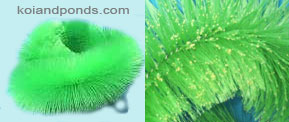1. Selection of the
Parents.
Choosing the right parents for
your baby koi need not be difficult, but it can sometimes be tricky
too. First things first - you need to know which of your koi
are female and which are male. Female koi are visibly rounder
than male koi, especially those that are ready to lay eggs.
Males are slimmer in appearance, and may develop roughness on their
gill plates when ready to spawn.
Choose mature koi only for
breeding, i.e., they should at least be two years old (younger koi
will produce weak offsprings). Experts say that the optimum
breeding age is 2-4 years old. Choose only healthy koi with no
deformities whatsoever. Both parents should exhibit excellent
body conformation and high-quality colors and markings.
Select the parents based on
what baby koi you're after. For example, if you want Kohaku
fry, then you need both parents to be Kohaku. Some varieties
don't result in nice koi when bred together, so be sure to do a
little research on koi variety pairing before doing it (unless
you're after the excitement of uncertainty).
Some breeders use two males for
a single female during breeding to maximize the yield of the
propagation. The breeding act of the koi is very physical and
can harm the participants (especially the female if the males are
very aggressive), so this ratio of 2:1 must not be exceeded.
One advantage of using just a single male is the higher
predictability of what the offspring will look like.
2. Preparation of the
Spawning Environment.
Once
the prospective parents have been identified, they need to be
taken out of the main pond and isolated in separate and smaller
ponds where they can be conditioned for spawning. Males are
separated from females to prevent indiscriminate spawning.
Many hobbyists start this
isolation at least 1 month before the anticipated
spawning date.
Eventually the female becomes
rounder and noticeably bloated with eggs. Now with a heavy but
soft abdomen, she is presumed to be ready to lay eggs and is very
carefully moved to the spawning pond. This pregnant koi must
always be supported by water during the move, even while inside a
net. At this point the male is also assumed to be ready
to participate in the reproduction as well, and is moved into the
spawning pond a few hours after the female has already been
acclimatized to it. Many breeders introduce the male in the
evening, since spawning usually happens in the wee hours of the
morning.
The spawning pond shouldn't be
big - usually with an area of just 6 to 12 sq. meters. It
should be thoroughly cleaned and filled with un-chlorinated water to
a depth of about 50 centimeters. The spawning pond must have a generous amount of spawning
material to encourage the female to lay her eggs on them. Many
modern koi hobbyists prefer synthetic spawning ropes
(see Figure 1) as
spawning material because these are free of parasites, do not easily
get damaged, and
allow easy handling of the eggs, unlike spawning media of the
natural kind. The easy-to-handle feature is important if you plan to move the eggs away from the parents
right after spawning is completed. Many old-school breeders
still prefer natural spawning material though.
 |
|
Figure 1. A
curled spawning rope (left) and a close-up of the
spawning rope bristles (right); Photo sources:
koilogic.co.uk;
keepkoi.com |
The spawning pond must also be sufficiently aerated at all times.
Strong but silent air pumps must be used. Unlike the main
pond, aeration of a spawning pond must not result in water
turbulence, since water tranquility is needed during spawning.
As such, the aeration system of the spawning pond must be designed
well to meet the aeration requirements without disturbing the water.
Proceed to Page 2...
